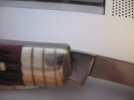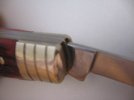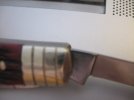- Joined
- Sep 28, 2005
- Messages
- 4,527
I recently got my first congress, and without ever holding another I was wondering if the gap between bolster and blade alignment in the open position is normal for a reverse held whittler like the congress. It is a new Boker, and I love the jigging (possibly my favorite in my collection) and color on the scales. I wish the blade shapes were all different, but may change this myself. I am carrying it on and off in order to get to know it better.

Thanks all.
Thanks all.



